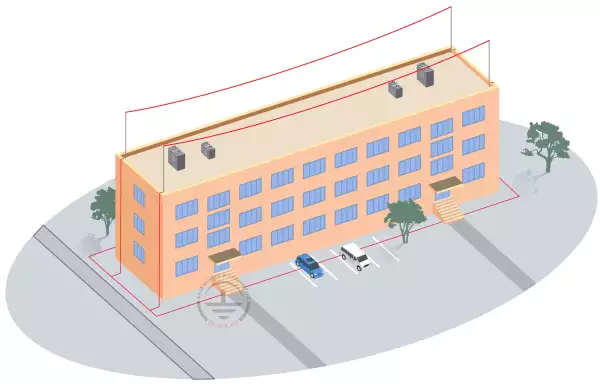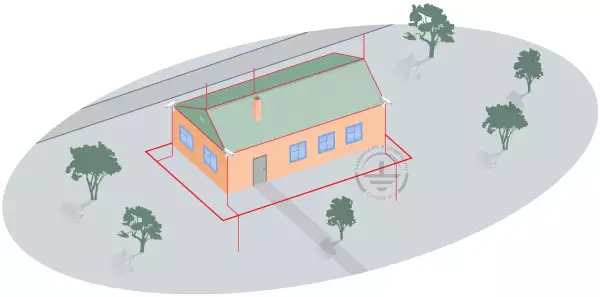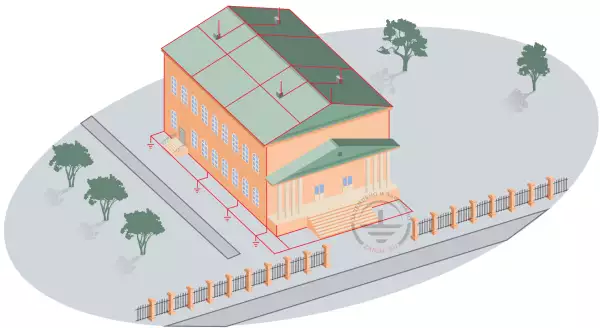Surge arresters of class II should limit all kinds of atmospheric induced surge voltages, switching overvoltages and also surges passed through surge arresters of class I in a multi-stage protection scheme (Fig. 2.1 and 2.2.). Typical protection levels of such surge arresters often do not exceed 1000 V or 1500 V. These voltage values can withstand the major part of electrical and electronic devices
Discharge rated current that can flow through the multiple surge arrester of class II, without causing damage, is typically selected from a number of values 2, 3, 5, 10, 15 or 20 kA.
Temporary current pulse is characterised by rise time of the edge of 8 ms and lifetime of impact stress wave half-recession of 20 microseconds.
The multi-stage protection systems, surge arresters of class II are used as the second protection stage from the part of lightning current and all kinds of surges.
They can also create the first stage of protection. Such decisions are acceptable if there is no possibility of:
- a direct lightning strike into the building site as well as to its power network of low voltage (only induced atmospheric overvoltage appear),
- a direct lightning strike to the building site, to which the network is connected with the help of the corresponding protected (cable) input.
Surge arresters of class II oroduced by LEUTRON can be divided into two main groups:
- Consisting of voltage-dependent resistors only,
- Containing series-connected voltage-dependent resistors and surge arresters.
The main types of arresters of class II produced by LEUTRON are shown in Fig. 3.1, and their main parameters are given in Table 3.1.
| EnerPro C | EnerPro C TN | EnerPro C S 275V |
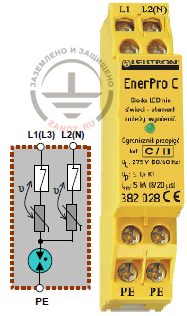 |
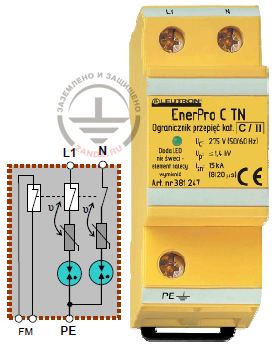 |
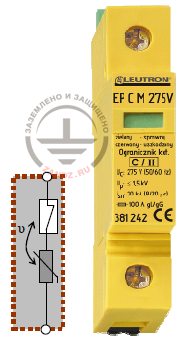 |
Fig.3.1. Examples of various arresters of class II
It must be remembered that before proceeding with the insulation testing of electrical equipment, it is necessary to disconnect surge arresters of class II from the mains supply or remove their plug-in modules. The reason is the relatively low voltage of these elements' activation and the possibility of damage during measuring of the insulation resistance.
| Table 3.1. The main parameters of Class II arresters | ||||
|---|---|---|---|---|
| ARRESTER TYPE | EnerPro C | EnerPro C TN | EnerPro C S 275V | |
| Response static voltage | UN | 230/400 V | 230/400 V | 230/400 V |
| The greatest long-term operating voltage | Uc | 275/480 V | 275 / 480V | 275 |
| Voltage level of arrester at 1 kV / microsecond (L (N) - PE) | Uas | ≤ 1400 V | ≤ 1400 V | ≤ 1400 V |
| The voltages reduced during the flow of nominal discharge current | Ures | ≤ 1400 V | ≤ 1400 V | ≤ 1400 V |
| Nominal discharge current (8/20 ms) | In | 15 kA | 15 kA | 20 kA |
| Maximum discharge current | Imax | 18 kA | 40kA | 40 kA |
| Resistance to shock currents 10/700 microseconds | Is | 500x100A 100x500A | 500x100A 100x500A | |
| Maximum preceding fuse in equipment | 100 A gL | 100 A gL | 100 gL | |
| Operating temperature areas | υ | -250...+850 | -400...+800 | -400...+800 |
| Item number | LE-382-028 | LE-381-247 | LE-381-270 | |
| Item number (version with performance tracking) | LE-382-029 | LE-381-248 | LE-381-275 | |
| Assembly | On a bus 35 mm | |||
In case of overvoltage protection systems arrangement TN-C, TN-S or TT ready modular units can be applied (Fig. 3.2 and 3.3).
4. Surge arresters of class III
Surge arresters of class III must provide protection of devices from overvoltages of atmospheric origin, induced, and switching surges, occurring inside the object.
In most cases, two-stage protection system consisting of arresters of I and II classes, provides sufficient protection of electrical and electronic devices. Arresters of class III often complement multi-stage protection systems. Prior to their selection, it is necessary to accurately analyze the feasibility of their use. A classic example of their use is an overdistance between the arresters of class II and the protected equipment. In practice, it should be considered that the distance of a few tens of meters poses a threat to the occurrence of greater surge at the terminals of protected equipment than it can sustain, in terms of the possibility of additional surge in the cable that connects the arrester of Class II with the equipment to be protected, for example as a result of flowing of lightning currents through conductors of lightning protection system of the protected object.
On the electrical equipment of construction sites, the arresters of Class III can be fixed in switchboards, cable ducts, directly in jacks or as portable devices connected into jacks.
Exemplary solutions of Class III arresters intended for mounting in switchboards are shown in Fig. 4.1. Technical parameters for these arresters are shown in Table 4.1.
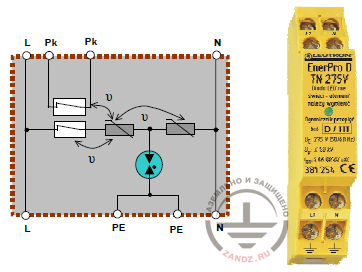 |
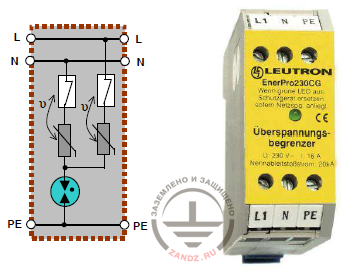 |
| EnerPro D TN 275V | EnerPro230CG |
Fig.4.1. Arresters of Class III, designed for mounting in control cabinets
Related Articles:
 ZANDZ SMS-NEWSLETTER
ZANDZ SMS-NEWSLETTER
